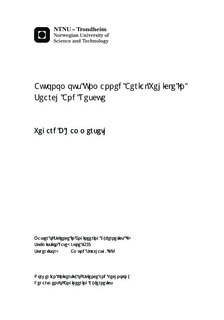| dc.description.abstract | This report presents a way of using autonomous drones to enhance search and rescue operations and takes the first steps in bringing the system to life. By using autonomous drones, less experience is required by the rescue personnel and drone specialists become excessive in this matter. Due to autonomy a drone can operate outside a valid radio link. Hence, when signal is lost, the craft can continue to search, buffer the information and send it when the link becomes active. By creating affordable drones the threshold decreases for deploying a unit in bad weather or other missions where the feedback is more important than drone return.Because the drones must sweep a large area, an aeroplane is the best suitable airframe. To generate less drag and increase stability; long, slender and thin-as-possible wings are recommended. To achieve aerodynamic stability, non-swept wings and a small positive dihedral angle is also advised. The wings should be attached on top of a slender and small-as-possible fuselage. However, due to the difficulties in landing and vulnerabilities related to this, a flying wing which obey the same design requirements, may be a better choice. A prototype for a flying wing made in expanded polypropylene was put together and tested. It proved to be resilient, able to withstand significant abuse, quickly recover to its former structure and be repaired in minutes. Highly convenient for various landing areas.An attitude and heading reference system (AHRS) is required to tell which orientation a vehicle may have. An affordable version has been realised by using micro electro mechanical sensors and a micro controller. Since the vehicle must orient itself within a search area, a NAVSTAR Global Positioning System (GPS) and way-point approach were drones are pre-programmed to follow a path has been developed together with a complete flight system.The drones search path must be programmed automatically from the given search area by the rescue personnel. This requires software and active communication link between a ground station and drones. An intuitive graphical user interface has been developed and verified to work by marking an area in the program and send coordinates over a commercial communication link to a prototype drone.A thermal imaging camera can be used to detect humans. It will make mammals stand out in an environment when viewed in the produced image (thermogram). Together with an arbitrarily threshold limit, the operators can be notified with coordinates when the threshold is reached. An experiment was carried out by placing a human at known coordinates. A drone with self position equipment was sent over the human repeatedly, automatically locating the person and reporting its location. It was concluded that the drone would be within 20 meters radius of the person.The generality and affordability of the airframe, AHRS and vision system can be useful for the university in the years ahead and the threshold for realising applications which uses any of these systems has therefore been reduced. A drone based system like this can enhance search and rescue and assist the majority by saving time, money and lives. | nb_NO |

